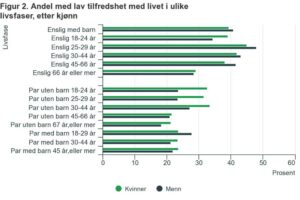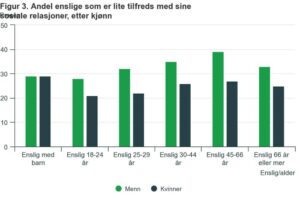Worse quality of life for single people
The quality of life survey shows that social relationships are important for quality of life. Single people have a worse quality of life than people with a partner, and especially single men are less satisfied with their social relationships compared to single women.
From previous analyzes based on the Quality Survey Life followsthat men and women are almost equally satisfied with their lives. At the same time, the quality of life of women and men may be determined by what stage of life we are in, and if we take into account several explanatory variables, there may be patterns typical of the quality of life of women and men.
Gender differences in quality of life seem to be related not only to age but also to the type of family you live in. The combination of age and family type is referred to as the life phase. Throughout this article, we'll take a closer look at how life stage can influence gender differences in quality of life.
Biggest gender difference between youngest and oldest
In the population, the youngest are the least satisfied, as well as a relatively large percentage of the oldest with low satisfaction. Women in these extreme age comparisons are less satisfied than men. In the other age groups there are differences between the sexes, but they are small.
Figure 1 shows that young people are less satisfied with their lives than older people, with young and older women reporting slightly less satisfaction than men of the same age. The figure also shows that the percentage of people with a low level of satisfaction decreases with age for all people up to 45 years of age. There are also slight differences between the sexes from about age 25 to mid-30s. In the age group of 44-45 there are fewer people with low satisfaction compared to younger age groups for both sexes, with the percentage of men with low satisfaction decreasing from the age of 45, while increasing among women. The gender gap in life satisfaction is also greatest in the 66-XNUMX age group. The difference between men and women is also quite large among the oldest.
Read our next article: Retirement for singles
Social relationships affect the quality of life. Having someone to confide in, get support from, and share daily life with is considered positive for quality of life. Attachment to others changes throughout life and, for example, there are more singles among the young and the elderly. It can reasonably be assumed that cohabitants have greater access to close social relationships than single people.
Figure 1. Share of the population in different age groups with a low level of satisfaction, broken down by gender. 2021

Lonely people are the least satisfied with life
The quality of life study shows that compared to other types of families, those who report low life satisfaction the most. They often have worse conditions and quality of life than people who live with a partner or have a boyfriend. Nearly 40 percent of the Norwegian population over the age of 18 is single people. Women to a slightly greater extent than men (37 and 32 percent, respectively), mainly because there are more single elderly women than men. Almost everyone in the 18-24 age group is single (98%). Most people between the ages of twenty and forty are in relationships, but the percentage of single men at this stage is slightly higher than women. After the age of 45, women are more likely than men to remain single.
Figure 2 shows that single people in all age groups have lower life satisfaction compared to other phases of life. More than 2 in 5 single people aged 30-44 (42%) are dissatisfied with their lives. This is almost twice as much as for everyone in this age group. Among singles in the age groups 18-29 and 45-66, less than 40% are dissatisfied. From the retirement age, the percentage of single people with a low level of satisfaction is lower compared to the total number of single people.
With the exception of the youngest, oldest and singles with children, singles have the highest percentage of men with low satisfaction in all age groups. Among the youngest singles (aged 18-24), women feel the general low satisfaction with life to the greatest extent, while among singles aged 30 and up to the retirement age, low satisfaction is reported by men. slightly more than women. Other indicators of the quality of life show that especially single men aged 30-44 are also less optimistic about the future and experience less meaning in life than women in the same phase of life.
Figure 2. Percentage of people with low life satisfaction in different life stages by gender

The importance of other social relationships for single people
As mentioned, relationships and social ties are important for quality of life. So far we have assumed that single people have poorer social relationships on average because they are not cohabiting, we have seen that single people are less satisfied with their lives. To further measure the relational dimension of quality of life, we use another question in the survey where respondents took a stance on the claim that "my social relationships are supportive and satisfying."
The first thing we can see in Figure 3 is that women, almost regardless of their stage of life, are more satisfied with their social relationships than men. When it comes to low satisfaction with social relationships among single people, the greatest differences between men and women are found among middle-aged people, aged 30-44 and 45-66. On the social relations index, single men have the lowest satisfaction of all age groups.
Chart 3. Percentage of singles dissatisfied with their social relationships, broken down by gender

Are single women more socially oriented?
The biggest difference between the sexes is the percentage of people with low satisfaction among singles aged 45-66. The percentage of single men with a low level of satisfaction in this age group is 39%, among women it is 27%. Gender difference by as much as 12 percentage points. That women establish the mechanisms of social relationships earlier in life may be a result here.
In the 18-24 age groups, 21 percent of women and 28 percent of men are dissatisfied with their social relationships, the difference between the sexes is 7 percentage points. The gender gap is even greater in the 25-29 and 30-44 age groups, 10 percentage points among those aged 25-29 and 9 percentage points among those aged 30-44. The gender difference in satisfaction with social relationships is present early in life. There are probably several reasons for this, but perhaps it is due to the fact that women here are already making more connections and are open to social relations. Later in life, fewer men than women give birth to children.
On the one hand, it may be that more women decide to live alone, which makes them more satisfied with their situation. On the other hand, it may also happen that women establish mechanisms of social satisfaction to a greater extent than men, both as singles and non-singles. For example, it is common to believe that women have friends they can confide in more than men. Having someone to talk to and share challenges with can in itself have a positive impact on your quality of life.
In addition, childlessness is more common among men than women. While a direct association of childlessness with quality of life itself is unlikely, it is possible that childlessness has an impact on the group of single men and their social satisfaction. Especially when we observe it in the 45-66 age group, where not having children may have had a greater impact on the quality of life. Childlessness among women is relatively low and stable (Jensen and Østby, 2014). This may be related to the fact that single women to a slightly greater extent experience the meaning of life and greater optimism for the future than men in the same situation.
There are more women among single people with children and in older age groups, especially those over 66 years of age. Much of this is probably due to the fact that women live longer on average than (their) men. Being single with children is the phase of life in which women are least satisfied with their social relationships (29%), but it is exactly the same percentage as among single men with children.
Quality of life in Norway - Gender differences in the living conditions of singles
There are many conditions that affect the quality of life, such as living conditions such as finances and education. Among other things, we see that single people with low education are even more dissatisfied with their social relationships than those living in couples. Although among people with low education the percentage of single people with low satisfaction with social relationships is higher for both sexes compared to people with a partner, the gender difference among single people with low education is smaller. We observe the same pattern in the case of low-income single people. The gender gap in satisfaction with social relationships is smaller when only low-income individuals are considered. At the same time, there is a significant difference. Among low-income single men, 38 percent are dissatisfied with social relations, the corresponding percentage among women is 25%.
For young people, education and income levels cannot be as important from a gender and life stage perspective, precisely because many of them have not yet completed their education and do not have a stable income. On the other hand, for people over 30, life satisfaction should be considered in the light of living conditions. Here, the vast majority completed their education, built their income and position on the labor market.
In conclusion, the relationship between quality of life and gender in the light of life stage is complex. Age, living conditions, and socioeconomic status have impacts on quality of life that this analysis cannot reveal. However, the article showed us that the quality of life is dynamic and changes throughout life. Our data show that quality of life is age-dependent in the sense that it is worse among younger people, then improves in adulthood, and worsens again among older people. The influence of age is significant in all phases of life, but especially among single people.
We have also seen that there are gender differences in this process that are related to the stage of life and attachment to close relationships. Single people are less satisfied with their lives than those in relationships. This applies to both women and men. Low attachment to social relationships has a particularly bad effect on single men. The older they get, the more social relationships seem to correlate with their satisfaction (except for the oldest). In the age groups 30-44 and 45-66, there are especially many men who are dissatisfied with social relations in comparison with similar women. In addition, single men aged 30-44 experience a lower sense of meaning in life and optimism for the future. Satisfaction of women and men is further undermined by low education or low income,




